Earl Kilbride, MD, MHA
Board Certified Orthopedic Surgeon
When you need a specialized type of surgery, like shoulder arthroscopy and repairs, you need a true specialist, like the ones at Austin Orthopedic Institute. As shoulder surgery experts, our providers regularly perform fracture fixation, rotator cuff repairs, tendon reattachment, and shoulder instabilty surgeries, and other types of shoulder repair and reconstruction with a focus on optimal outcomes for every patient.
A shoulder arthroscopy is a minimally invasive procedure used for diagnosis and treatment of shoulder arthritis, and other conditions that cause shoulder pain.
In a shoulder arthroscopy, your provider creates a tiny incision in your shoulder. Through this incision, they will place an arthroscope – a thin, lighted tube containing a small camera – that sends images to a monitor that is then used to view the inside of your shoulder joint.
Arthroscopies are used to diagnose problems and determine the extent of damage. Even MRI’s will understate the problem at times, but direct visualization rarely does.
Depending on the extent of your shoulder issues, your provider may also make a few more small incisions. Small surgical tools will then be placed in the additional incisions, allowing your provider to perform repairs while watching the monitor.
The many types of arthroscopic repairs include:
Arthroscopy allows your provider to remove cartilage and other tissues, and restore your function, without the need for invasive surgery or large incisions.
In fact, shoulder arthroscopies are typically performed as outpatient procedures, as they only take about 30 minutes.

In some cases, you might require shoulder replacement rather than a less-invasive procedure, like shoulder arthroscopy. Shoulder arthroscopy is helpful as a diagnostic tool, and it’s an excellent option for minimally invasive shoulder repairs – but it does have limits.
Arthroscopy can allow intricate repair work to be done in a very small space with minimal incisions. For earlier arthritis, it may help buy time by removing spurs, smoothing cartilage, or releasing scar tissue.
However, if you have shoulder pain and other symptoms because of bone-on-bone arthritis, your provider cannot restore cartilage where none exists. Shoulder joint replacement might be the best option to ease your symptoms long term.
After shoulder arthroscopy, we provide you with recovery instructions specific to your procedure and issue. Shoulder arthroscopy offers a faster recovery than full joint replacement, but it can still take anywhere from a few weeks to several months to recover fully.